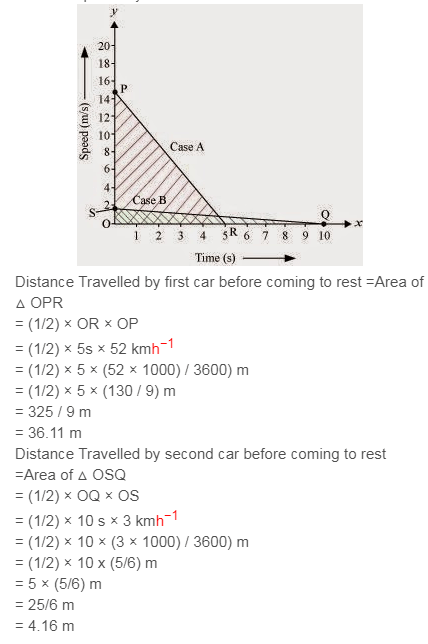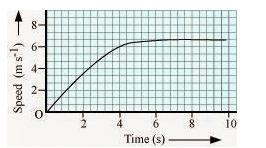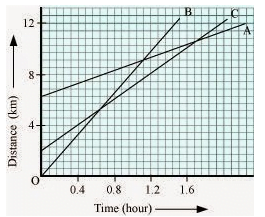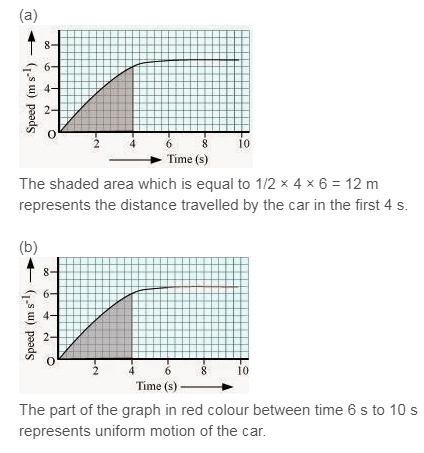NCERT Solution Class 9th Science Chapter 8: Motion, NCERT Solutions for Class 9 Science (Chemistry) Chapter 8 – Motion solved by Expert Teachers as per NCERT (CBSE) Book guidelines. These solutions are part of NCERT Solutions for Class 9 Science. Here we have given Class 9 NCERT Science Textbook Solutions for Chapter 8 Motion.
NCERT
Solution Class
9th Science Chapter 8:
Motion
1: An object has moved through a distance. Can it have zero displacements? If yes, support your answer with an example.
Answer: Yes, zero displacements is possible if an object has moved through a distance.
Suppose a body is moving in a circular path and starts moving from point A and it returns back at same point A after completing one revolution, then the distance will be equal to its circumference while displacement will be zero.
2: A farmer moves along the boundary of a square field of side 10 m in 40 s. What will be the magnitude of displacement of the farmer at the end of 2 minutes 20 seconds from his initial position?
Answer:
Given, side of the square field = 10 m
Therefore, perimeter = 10 m × 4 = 40 m
Farmer moves along the boundary in 40 s
Time = 2 minutes 20 s = 2 × 60 s + 20 s = 140 s
since, in 40 s farmer moves 40 m
Therefore, in 1s distance covered by farmer = 40 ÷ 40 = 1m.
Therefore, in 140s distance covered by farmer = 1 × 140 m = 140 m
Now, number of rotation to cover 140 along the boundary =
Total distance perimeter
= 140 m ÷ 40 m = 3.5 round
Thus after 3.5 round farmer will at point C (diagonally opposite to his initial
position) of the field.
Therefore, Displacement
AC = 102+102 = 200 =102m
Thus, after 2 minutes 20 second, the displacement of the farmer will be equal
to 10√2 m northeast from initial position.
3: Which of the following is true for displacement?
(a) It cannot be zero.
(b) Its magnitude is greater than the distance travelled by the object.
Answer:
None of (a) and (b) are true.
NCERT Solution Class 9th Science Chapter 8: Motion
See Also: NCERT Solutions for Class 9th: Ch 8 Motion Science
1: Distinguish between speed and velocity.
Answer: Speed has only magnitude while velocity has both magnitude and direction. So speed is a scalar quantity but velocity is a vector quantity.
2: Under what condition(s) is the magnitude of the average velocity of an object equal to its average speed?
Answer: The magnitude of the average velocity of an object will be equal to its average speed in the condition of uniform velocity in a straight line motion.
3: What does the odometer of an automobile measure?
Answer: In automobiles, the odometer is used to measure the distance.
4: What does the path of an object look like when it is in uniform motion?
Answer: In the case of uniform motion, the path of an object will look like a straight line.
5: During an experiment, a signal from a spaceship reached the ground station in five minutes. What was the distance of the spaceship from the ground station? The signal travels at the speed of light, that is,
3×108 ms-1
Answer:
Here we have,Speed=3x108ms-1Time=5min=5×60=300 secs.Distance= Speed x TimeDistance= 3 x 108 ms-1 x 300 secs. = 9x 1010m
NCERT Solution Class 9th Science Chapter 8: Motion
See Also: NCERT Solutions for Class 9 Science Chapter 8
1: When will you say a body is in
(i) uniform acceleration?
Answer: A body is said in uniform acceleration when its motion is along a straight line and its velocity changes by equal magnitude in equal interval of time.
(ii) non-uniform acceleration?
Answer: A body is said in non-uniform acceleration when its motion is along a straight line and its velocity changes by unequal magnitude in equal interval of time.
2: A bus decreases its speed from 80 km/h to 60 km/h in 5 s. Find the acceleration of the bus.
Answer:
Here, u = 80 km/h =80x10003600ms-1 = 2009ms-1 v= 60 km/h = 60×10003600 ms-1 = 1509 ms-1 t = 5s therefore, acceleration, a=?We know that, v=u+at⇒a= v-ut=(1509-2009)5=-5095=-109=1.1 ms-2Therefore, Acceleration is -1.1 ms-2
3: A train starting from a railway station and moving with uniform acceleration attains a speed of 40 km/h in 10 minutes. Find its acceleration.
Answer:
Initial velocity of the train, u= 0Final velocity of the train, v= 40 km/h= 40 x 518=11.11m/sTime taken,t= 10min =10 x 60 = 600sAcceleration, a= v-ut=11.11-0600= 0.0185 m/s2hence, the acceleration of the train is 0.0185 m/s2.
1: What is the nature of the distance-time graphs for uniform and non-uniform motion of an object?
Answer:
- The slope of the distance-time graph for an object in uniform motion in
a straight line. - The slope of the distance-time graph for an object in non-uniform motion is not a straight line.
2: What can you say about the motion of an object whose distance-time graph is a straight line parallel to the time axis?
Answer: When the slope of the distance-time graph is a straight line parallel to the time axis, the object is stationary.
3: What can you say about the motion of an object if its speed-time graph is a straight line parallel to the time axis?
Answer: When the graph of a speed-time graph is a straight line parallel to the time axis, the object is moving with constant speed.
4: What is the quantity which is measured by the area occupied below the velocity-time graph?
Answer: The quantity of distance is measured by the area occupied below the velocity-time graph.
1: A bus starting from rest moves with a uniform acceleration of 0.1ms–2 for 2
minutes. Find
(a) the speed acquired,
(b) the distance travelled.
Answer: Here we have,
Initial velocity (u) = 0 m/s
Acceleration (a) = 0.1ms–2
Time (t) = 2 minute = 120 seconds
(a) The speed acquired:
We know that, v = u + at
⇒ v = 0 + 0.1 × 120 m/s
⇒ v = 12 m/s-1
Thus, the bus will acquire a speed of 12 m/s after 2 minutes with the given
acceleration.
(b) The distance travelled:
According to the third equation of motion: v2-u2= 2m/sWhere is the distance covered by the bus (12)2-(0)2=2(0.1)ss=720mSpeed acquired by the bus is 12m/s. Distance travelled by bus is 720m.
Thus, the bus will travel a distance of 720 m in the given time of 2 minutes.
NCERT Solution Class 9th Science Chapter 8: Motion
[table id=1 /]
2: A train is travelling at a speed of 90 km/h. Brakes are applied so as to produce a uniform acceleration of – 0.5 m/s2. Find how far the train will go before it is brought to rest.
Answer:
Here, we have,
Initial speed of the train, u= 90 km/h= 25m/s final speed of the train, v= 0According to third equation of motion:v2= u2+2(0)2= (25)2+2(-0.5)sWhere, s is the distance covered by the trains= 2522(0.5)= 625 m.
Therefore, the train will go 625 m before it brought to rest.
3: A trolley, while going down an inclined plane, has an acceleration of 2 cm/s-2. What will be its velocity 3 s after the start?
Answer: Here we have,
Initial velocity, u = 0 m/s
Acceleration (a) = 2 cm/s-2 = 0.02 m/s-2
Time (t) = 3 s
Final velocity, v =?
We know that, v = u + at
Therefore, v = 0 + 0.02 × 3 m/s
⇒ v = 0.06 m/s
Therefore the final velocity of a trolley will be 0.06 m/s after the start.
4: A racing car has a uniform acceleration of 4 m/s2. What distance will it cover in 10 s after start?
Answer:
Here we have,
Acceleration, a = 4 m/s-2
Initial velocity, u = 0 m/s
Time, t = 10 s
Distance covered (s) =?
We know that, s = ut +(1/2)at2
Therefor , Distance covered by car in 10 second
= 0 x 10+(1/2) x 4 x 102
s = 200 m
Thus, the racing car will cover a distance of 200 m after a start in 10 s with given
acceleration.
5: A stone is thrown in a vertically upward direction with a velocity of 5 m/s-2. If the acceleration of the stone during its motion is 10 m/s-2 in the downward direction, what will be the height attained by the stone and how much time will it take to reach there?
Answer:
Here we have,
Initial velocity (u) = 5 m/s
Final velocity (v) = 0 m/s
Acceleration (a) = – 10 m/s-2
Height, i.e. Distance, s =?
Time (t) taken to reach the height =?
We know that, v2 = u2 + 2as
⇒ 0 = (5)2 + 2 × −10 × s
⇒ 0 = 25 − 20s
⇒ s = 25/20m
⇒ s = 1.25 m
Now, we know that, v = u + at
⇒ 0 = 5 + (–10) × t
⇒ 0 = 5 − 10t
⇒ t = 5/10 s
⇒ t = 0.5 s
Thus, stone will attain a height of 1.25 m and time taken to attain the height is
0.5 s.
Exercises
1: An athlete completes one round of circular track of diameter 200 min 40 sec. What will be the distance covered and the displacement at the end of 2 minutes 20 sec?
Answer:
Diameter of circular track D=200 radius of circular trackr=200/2=100m time taken by the athlete for one roundt=40 distance covered by athlete in one rounds=2πr=2 x 22/7 x 100Speed of the athlete (v)= Distance/Time=2 x 22007 x 40=44007 x 40Therefore, Distance covered in 140 s = Speed(s) x Time(t)=4400(7 x 40) x (2 x 60 + 20)= 4400 x 1407 x 40=2200m Number of round in 40s =1 round number of round in 140s =140/40=312after taking start from position X, the athlete will be at position After 312 rounds.hence, Displacement of the athlete with respect to the initial position at x=xy.= Diameter of circular track=200 m.
NCERT Solution Class 9th Science Chapter 8: Motion
See Also: NCERT Solution Class 9th Science Ch 7: Diversity In Living Organisms
2: Joseph jogs from one end A to another end B of a straight 300 m road in 2 minutes and 30 sec and then turns around and jogs 100 m back to point C in another 1 minute. What are Joseph’s average speeds and velocities in jogging (a) from A to B and (b) from A to C?
Answer:
(a) For motion from A to B:
Distance covered = 300 m
Displacement = 300 m.
Time taken = 150 sec.
We know that, Average speed = Total distance covered ÷ Total time taken
= 300 m ÷ 150 sec = 2 ms-1
Average velocity = Net displacement ÷ time taken
= 300 m ÷ 150 sec = 2 ms-1
(b) For motion from A to C:
Distance covered = 300 + 100 = 400 m.
Displacement = AB – CB = 300 – 100 = 200 m.
Time taken = 2.5 min + 1 min
= 3.5 min = 210 sec.
Therefore, Average speed = Total distance covered ÷ Total time taken
= 400 ÷ 210 = 1.90 ms-1.
Average velocity = Net displacement ÷ time taken
= 200 m ÷ 210 sec
= 0.952ms-1.
3: Abdul, while driving to school, computes the average speed for his trip to be 20 km h-1. On his return trip along the same route, there is less traffic and the average speed is 30 km h-1. What is the average speed of Abdul’s trip?
Answer: Let one side distance = x km.
Time taken for forward trip at a speed of 20 km/h = Distance / Speed = x/20 h.
Time taken in return trip at a speed of 30 km/h = x/30 h.
Total time for the whole trip =
x20+x20=3x + 3×60=5x60h
Total distance covered = 2x km.
We know, Average speed = Total distance ÷ Total time
= 2x ÷ (5x/60)
= 24 kmh-1.
4: A motor boat starting from rest on a lake accelerates in a straight line at a constant rate of 3.0 ms-2 for 8.0 s. How far does the boat travel during this time?
Answer: Here, u = 0 m/s
a = 3 ms-2
t = 8 s
Using, s = ut + ½ at2
s = 0 × 8 + ½ × 3 ×
82
= 96 m.
5: A driver of a car travelling at 52 km h-1 applies the brakes and accelerates uniformly in the opposite direction. The car stops after 5 s. Another driver going at 34 km h-1 in another car applies his brakes slowly and stops in 10 s. On the same graph paper, plot the speed versus time graphs for two cars. Which of the two cars travelled farther after the brakes were applied?
Answer:
In in the following graph, AB and CD are the time graphs for the two cars whose initial speeds are 52 km/h(14.4 m/s) and 34 km/h(8.9 m/s), respectively.

6: Fig 8.11 shows the distance-time graph of three objects A, B and C. Study the graph and answer the following questions:
(a) Which of the three is travelling the fastest?
(b) Are all three ever at the same point on the road?
(c) How far has C travelled when B passes A?
(d) How far has B travelled by the time it passes C?
Answer:
(a) B is travelling fastest as he is taking less time to cover more distance.
(b) All three are never at the same point on the road.
(c) Approximately 6 km. [as 8 – 2 = 6]
(d) Approximately 7 km. [as 7 – 0 = 7]
7: A ball is gently dropped from a height of 20 m. If its velocity increases uniformly at the rate of 10ms-2, with what velocity will it strike the ground? After what time will it strike the ground?
Answer:
Here, u = 0 m/s, s = 20 m, a = 10 ms-2, v = ?, t = ?
Using v2 – u2 = 2as
We have, v2 – 02 = 2 × 10 × 20 = 400 ⇒ v = 20 ms-1.
and t = (v – u) ÷ a = 20 ÷ 10 = 2 s.
8: The speed-time graph for a car is shown in Figure:

(a) Find how far does the car travel in the first 4 seconds. Shade the area on the graph that represents the distance travelled by car during the period.
(b) Which part of the graph represents the uniform motion of the car?
Answer:
9: State which of the following situations are possible and give an example of each of the following:
(a) an object with a constant acceleration but with zero velocity,
Answer: Yes, a body can have acceleration even when its velocity is zero. When a body is thrown up, at the highest point its velocity is zero but it has acceleration equal to the acceleration due to gravity.
(b) an object moving in a certain direction with an acceleration in the
perpendicular direction.
Answer: Yes, an acceleration moving horizontally is acted upon by acceleration due to gravity that acts vertically downwards.
10: An artificial is moving in a circular orbit of radius 42250 km. Calculate its speed if it takes 24 hrs to revolve around the earth.
Answer: Here,
r = 42250 km = 42250000 m
T = 24 h = 24 × 60 × 60 s
Using Speed, v = 2πr ÷ T
v = (2 × 3.14 × 42250000) ÷ (24 × 60 × 60) m/s
= 3070.9 m/s = 3.07 km/s

Hi, I’m Dev Kirtonia, Founder & CEO of Dev Library. A website that provides all SCERT, NCERT 3 to 12, and BA, B.com, B.Sc, and Computer Science with Post Graduate Notes & Suggestions, Novel, eBooks, Biography, Quotes, Study Materials, and more.






